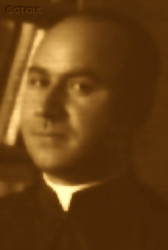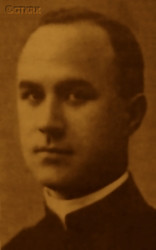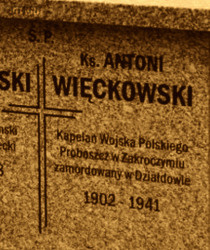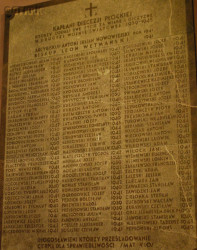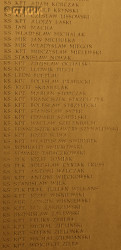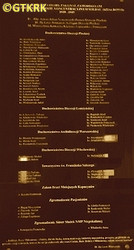Roman Catholic
St Sigismund parish
05-507 Słomczyn
85 Wiślana Str.
Konstancin deanery
Warsaw archdiocese, Poland
full list:
displayClick to display full list

searchClick to search full list by categories
wyświetlKliknij by wyświetlić pełną listę po polsku

szukajKliknij by przeszukać listę wg kategorii po polsku

Martyrology of the clergy — Poland
XX century (1914 – 1989)
personal data
surname
WIĘCKOWSKI
forename(s)
Anthony (pl. Antoni)
function
diocesan priest
creed
Latin (Roman Catholic) Church RCmore on
en.wikipedia.org
[access: 2014.09.21]
diocese / province
Płock diocesemore on
en.wikipedia.org
[access: 2013.05.19]
RC Military Ordinariate of Polandmore on
en.wikipedia.org
[access: 2014.12.20]
date and place
of death
19.01.1941

KL Soldauconcentration camp
today: Działdowo, Działdowo urban gm., Działdowo pov., Warmia‐Masuria voiv., Poland
more on
en.wikipedia.org
[access: 2018.09.02]
details of death
From 01.01.1939 chaplain of the Polish Army reserve.
In 08.1939 mobilised.
After German invasion of Poland on 01.09.1939 (Russians invaded Poland 17 days later) and start of the World War II, took part in battle of Warsaw, under siege from Germans.
After Warsaw fall on 27.09.1939 and after start of German occupation returned to his diocese.
Arrested, along with a friar of the local Capuchins monastery, Fr Ceslav Francis Kozera, by the Germans on 06.11.1940 (other dates the sources quote are 24.10.1940 and 04.11.1940) — from the denunciation to the Germ. Geheime Staatspolizei (Eng. Secret State Police), i.e. Gestapo, for burying the church bell in the monastery gardens and hiding liturgical vessels in an empty grave in the cemetery that the Germans unearthed during the searches.
Jailed in Nowy Dwór Mazowiecki prison.
On 09.01.1941 transported to KL Soldau concentration camp where was in all probability murdered.
Shot while being taken out of his cell.
cause of death
murder
perpetrators
Germans
sites and events
KL SoldauClick to display the description, Ribbentrop‐MolotovClick to display the description, Pius XI's encyclicalsClick to display the description
date and place
of birth
20.10.1902Birth certification on:
metryki.genealodzy.pl
[access: 2025.03.16]

Grodziectoday: Czerwińsk nad Wisłą gm., Płońsk pov., Masovia voiv., Poland
more on
en.wikipedia.org
[access: 2021.12.18]
parents
WIĘCKOWSKI Stanislav
🞲 ?, ? — 🕆 ?, ?

FERSKA Anne
🞲 ?, ? — 🕆 ?, ?
baptism
23.10.1902Birth certification on:
metryki.genealodzy.pl
[access: 2025.03.16]

Grodziectoday: Czerwińsk nad Wisłą gm., Płońsk pov., Masovia voiv., Poland
more on
en.wikipedia.org
[access: 2021.12.18]
St Bartholomew the Apostle RC church
presbyter (holy orders)
ordination
21.12.1929

Płocktoday: Płock city pov., Masovia voiv., Poland
more on
en.wikipedia.org
[access: 2021.12.18]
Assumption of the Blessed Virgin Mary RC cathedral churchmore on
en.wikipedia.org
[access: 2025.03.14]
positions held
1939 – 1940
parish priest — Zakroczymtoday: Zakroczym gm., Nowy Dwór Mazowiecki pov., Masovia voiv., Poland
more on
en.wikipedia.org
[access: 2021.12.18] ⋄ Exaltation of the Holy Cross RC church ⋄ St Joseph RC parish ⋄ Płońsktoday: Płońsk urban gm., Płońsk pov., Masovia voiv., Poland
more on
en.wikipedia.org
[access: 2021.12.18] RC deanery
1939
administrator — Skołatowotoday: Dzierzążnia gm., Płońsk pov., Masovia voiv., Poland
more on
en.wikipedia.org
[access: 2021.12.18] ⋄ St Acathius RC parish ⋄ Płońsktoday: Płońsk urban gm., Płońsk pov., Masovia voiv., Poland
more on
en.wikipedia.org
[access: 2021.12.18] RC deanery — acting („ad interim”)
1931 – 1939
prefect — Płocktoday: Płock city pov., Masovia voiv., Poland
more on
en.wikipedia.org
[access: 2021.12.18] ⋄ Minor Theological Seminary [i.e. St Stanislav Kostka's Gymnasium and Lyceum (from 1934) / St Stanislav Kostka's gymnasium at the Diocesan Seminary (from 1926) / St Stanislav Kostka's Lyceum at the Diocesan Seminary (from 1916)] — inspector
1930 – 1931
prefect — Gostynintoday: Gostynin gm., Gostynin pov., Masovia voiv., Poland
more on
en.wikipedia.org
[access: 2021.12.18] ⋄ Thaddeus Kościuszko's State Philological Gymnasium and public elementary school ⋄ St Martin the Bishop and Confessor RC parish ⋄ Gostynintoday: Gostynin gm., Gostynin pov., Masovia voiv., Poland
more on
en.wikipedia.org
[access: 2021.12.18] RC deanery
1929 – 1930
vicar — Płońsktoday: Płońsk urban gm., Płońsk pov., Masovia voiv., Poland
more on
en.wikipedia.org
[access: 2021.12.18] ⋄ St Michael the Archangel RC parish ⋄ Płońsktoday: Płońsk urban gm., Płońsk pov., Masovia voiv., Poland
more on
en.wikipedia.org
[access: 2021.12.18] RC deanery
1924 – 1929
student — Płocktoday: Płock city pov., Masovia voiv., Poland
more on
en.wikipedia.org
[access: 2021.12.18] ⋄ philosophy and theology, Theological Seminary
others related
in death
KOZERAClick to display biography Francis (Fr Ceslav), ARENDZIKOWSKIClick to display biography Adam, BARTUZIClick to display biography Thaddeus, BIAŁYClick to display biography Vladislav, BŁOŃSKIClick to display biography Vladimir Eugene, BROMIRSKIClick to display biography Vladislav John, BROSZKIEWICZClick to display biography Alexander Casimir, CABANClick to display biography Steven Ceslav, CIBOROWSKIClick to display biography Thaddeus, DMOCHOWSKIClick to display biography Peter Julian, GIERGIELEWICZClick to display biography Francis, GLINKAClick to display biography Francis (Bro. Anthony of the Annunciation to the Blessed Virgin Mary), GOSZCZYŃSKIClick to display biography Adam Lucian, JAWORSKIClick to display biography Stanislav, KACZOROWSKIClick to display biography Michael, KALISZKAClick to display biography Thaddeus Ignatius, KLENIEWSKIClick to display biography Eugene Paul, KLIMKIEWICZClick to display biography Francis Xavier Stanislav, KŁAPKOWSKIClick to display biography Vladislav, KOBYLIŃSKIClick to display biography Stanislav, KOLATORClick to display biography Bronislav, KOPERClick to display biography Bronislav, KOWALSKAClick to display biography Mieczyslava (Sr Mary Therese of Baby Jesus), KOZŁOWSKIClick to display biography John, KROGULECKIClick to display biography John Jerome, KRYSIAKClick to display biography Andrew, KRZEMIŃSKIClick to display biography John, KURACHClick to display biography Anthony, KURDZIELClick to display biography John, KUŚMIERCZYKClick to display biography Anthony, LATARSKIClick to display biography Joseph, ŁADAClick to display biography Alex, ŁUCZECZKOClick to display biography Emil, ŁUKASZEWICZClick to display biography Louis, MALINOWSKIClick to display biography Stanislav Adalbert, MIASTKOWSKIClick to display biography Anthony, MICHALAKClick to display biography Joseph, MODZELEWSKIClick to display biography Adolph, MOLAKClick to display biography Joseph Stanislav, MORAWSKIClick to display biography Michael, MOSSAKOWSKIClick to display biography Leo Julian, NASIŁOWSKIClick to display biography Stanislav, NOWOWIEJSKIClick to display biography Anthony Julian, OGRODOWICZClick to display biography Joseph, PAWLAKClick to display biography Anthony, PŁYWACZYKClick to display biography Adalbert, PRZYGÓDZKIClick to display biography Julian Ceslav, RAMOTOWSKIClick to display biography Vladislav, ROESLERClick to display biography Alexander Nicodemus, ROGALSKIClick to display biography Ceslav, ROSZKOWSKIClick to display biography Ceslav, ROŚCISZEWSKIClick to display biography Joseph, RUSZKOWSKIClick to display biography Francis Henry, SALWOWSKIClick to display biography Joseph, SKARŻYŃSKIClick to display biography Boleslav, SKIERKOWSKIClick to display biography Vladislav, SOBOCIŃSKIClick to display biography Joseph, STEFAŃCZYKClick to display biography Faustinus, STĘPKOWSKIClick to display biography Stanislav, STROJNOWSKIClick to display biography Joseph Valentine, SZCZEPAŃSKIClick to display biography John Casimir, SZYDŁOWSKIClick to display biography John, SZYMCZYKClick to display biography Joseph, TROJAŃCZYKClick to display biography Peter Alexander, WALCZAKClick to display biography Anthony, WETMAŃSKIClick to display biography Leo, WILKOWSKIClick to display biography Adam, WILOCHClick to display biography John Louis, WIŚNIEWSKIClick to display biography Eugene, ZALESKIClick to display biography Adam, ZALEWSKIClick to display biography Julian, ZAREMBAClick to display biography John, ZAWADZKIClick to display biography Adam John, ZAWIDZKIClick to display biography John, ŻOŁĘDZIOWSKIClick to display biography Casimir
sites and events
descriptions
KL Soldau: German Germ. Konzentrationslager (Eng. concentration camp) KL Soldau (in modern Działdowo city) — since the pre‐war Polish Działdowo county was incorporated into Germ. Regierungsbezirk Allenstein (Eng. Olsztyn regency) the camp was located in occupied territories where general German law was in force, i.e. in Germany proper — was founded in 09.1939, when in former barracks of 32nd Infantry Regiment of Polish Army Germans set up a temporary camp for POW captured during September 1939 campaign. In autumn 1939 was also used as police jail. In 1939‐1940 changed into Germ. Durchgangslager für polnische Zivilgefangene (Eng. Transit Camp for Polish Civilians), prior to transport to other concentration camps. In reality it was used then as a place of extermination of Polish intelligentsia within Germ. «Intelligenzaktion» genocidal program and extermination of sick and disabled within «Aktion T4» program. Next in 05.1940 the camp was changed again into Germ. Arbeitserziehungslager (Eng. Work Education Camp), and finally into penal comp for criminal and political prisoners, most of whom were sentenced to death. In 1939‐1941 Germans imprisoned, maltreated and tortured in KL Soldau hundreds of Polish priests and religious. Approx. 80 priests, religious and nuns perished. They were murdered in the camp itself, by a shot into a head, or in places of mass executions in nearby forests — Białuty forest, Malinowo forets, Komorniki. Dates and precise locations of these murders remain unknown. Altogether in KL Soldau approx. 15,000 prisoners were murdered, including thousands victims — patients of psychiatric institutions (within «Aktion T4» plan). (more on: mazowsze.hist.plClick to attempt to display webpage
[access: 2013.08.17], en.wikipedia.orgClick to attempt to display webpage
[access: 2018.09.02])
Ribbentrop‐Molotov: Genocidal Russian‐German alliance pact between Russian leader Joseph Stalin and German leader Adolf Hitler signed on 23.08.1939 in Moscow by respective foreign ministers, Mr. Vyacheslav Molotov for Russia and Joachim von Ribbentrop for Germany. The pact sanctioned and was the direct cause of joint Russian and German invasion of Poland and the outbreak of the World War II in 09.1939. In a political sense, the pact was an attempt to restore the status quo ante before 1914, with one exception, namely the „commercial” exchange of the so‐called „Kingdom of Poland”, which in 1914 was part of the Russian Empire, fore Eastern Galicia (today's western Ukraine), in 1914 belonging to the Austro‐Hungarian Empire. Galicia, including Lviv, was to be taken over by the Russians, the „Kingdom of Poland” — under the name of the General Governorate — Germany. The resultant „war was one of the greatest calamities and dramas of humanity in history, for two atheistic and anti‐Christian ideologies — national and international socialism — rejected God and His fifth Decalogue commandment: Thou shall not kill!” (Abp Stanislav Gądecki, 01.09.2019). The decisions taken — backed up by the betrayal of the formal allies of Poland, France and Germany, which on 12.09.1939, at a joint conference in Abbeville, decided not to provide aid to attacked Poland and not to take military action against Germany (a clear breach of treaty obligations with Poland) — were on 28.09.1939 slightly altered and made more precise when a treaty on „German‐Russian boundaries and friendship” was agreed by the same murderous signatories. One of its findings was establishment of spheres of influence in Central and Eastern Europe and in consequence IV partition of Poland. In one of its secret annexes agreed, that: „the Signatories will not tolerate on its respective territories any Polish propaganda that affects the territory of the other Side. On their respective territories they will suppress all such propaganda and inform each other of the measures taken to accomplish it”. The agreements resulted in a series of meeting between two genocidal organization representing both sides — German Gestapo and Russian NKVD when coordination of efforts to exterminate Polish intelligentsia and Polish leading classes (in Germany called «Intelligenzaktion», in Russia took the form of Katyń massacres) where discussed. Resulted in deaths of hundreds of thousands of Polish intelligentsia, including thousands of priests presented here, and tens of millions of ordinary people,. The results of this Russian‐German pact lasted till 1989 and are still in evidence even today. (more on: en.wikipedia.orgClick to attempt to display webpage
[access: 2015.09.30])
Pius XI's encyclicals: Facing the creation of two totalitarian systems in Europe, which seemed to compete with each other, though there were more similarities than contradictions between them, Pope Pius XI issued in 03.1937 (within 5 days) two encyclicals. In the „Mit brennender Sorge” (Eng. „With Burning Concern”) published on 14.03.1938, condemned the national socialism prevailing in Germany. The Pope wrote: „Whoever, following the old Germanic‐pre‐Christian beliefs, puts various impersonal fate in the place of a personal God, denies the wisdom of God and Providence […], whoever exalts earthly values: race or nation, or state, or state system, representatives of state power or other fundamental values of human society, […] and makes them the highest standard of all values, including religious ones, and idolizes them, this one […] is far from true faith in God and from a worldview corresponding to such faith”. On 19.03.1937, published „Divini Redemptoris” (Eng. „Divine Redeemer”), in which criticized Russian communism, dialectical materialism and the class struggle theory. The Pope wrote: „Communism deprives man of freedom, and therefore the spiritual basis of all life norms. It deprives the human person of all his dignity and any moral support with which he could resist the onslaught of blind passions […] This is the new gospel that Bolshevik and godless communism preaches as a message of salvation and redemption of humanity”… Pius XI demanded that the established human law be subjected to the natural law of God , recommended the implementation of the ideal of a Christian state and society, and called on Catholics to resist. Two years later, National Socialist Germany and Communist Russia came together and started World War II. (more on: www.vatican.vaClick to attempt to display webpage
[access: 2023.05.28], www.vatican.vaClick to attempt to display webpage
[access: 2023.05.28])
sources
personal:
mazowsze.hist.plClick to attempt to display webpage
[access: 2012.11.23], regis.maxus.com.plClick to attempt to display webpage
[access: 2012.12.28], metryki.genealodzy.plClick to attempt to display webpage
[access: 2025.03.16]
bibliographical:
„Płock diocese clergy martyrology during II World War 1939‐1945”, Fr Nicholas Marian Grzybowski, Włocławek–Płock 2002
original images:
regis.maxus.com.plClick to attempt to display webpage
[access: 2012.12.28], forum.tradytor.plClick to attempt to display webpage
[access: 2015.05.09], www.katedrapolowa.plClick to attempt to display webpage
[access: 2014.01.16], radioolsztyn.plClick to attempt to display webpage
[access: 2021.08.06]
LETTER to CUSTODIAN/ADMINISTRATOR
If you have an Email client on your communicator/computer — such as Mozilla Thunderbird, Windows Mail or Microsoft Outlook, described at WikipediaPatrz:
en.wikipedia.org, among others — try the link below, please:
LETTER to CUSTODIAN/ADMINISTRATORClick and try to call your own Email client
If however you do not run such a client or the above link is not active please send an email to the Custodian/Administrator using your account — in your customary email/correspondence engine — at the following address:

giving the following as the subject:
MARTYROLOGY: WIĘCKOWSKI Anthony
To return to the biography press below:
 Click to return to biography
Click to return to biography








